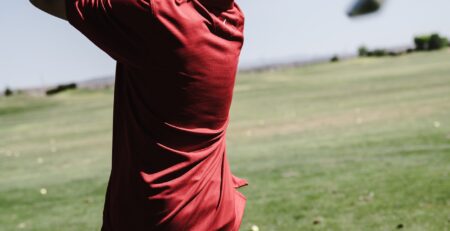Breaking Down the Key Elements of a Powerful and Efficient Swing
Golf may seem like a gentle sport, but anyone who has attempted to master it knows the monumental role of power and efficiency in a golf swing. The swing is the heart of golf, propelling the ball towards the hole.
An effective golf swing balances power and efficiency, translating to increased distance, accuracy, and consistency – key elements for achieving optimal performance on the course.
The Basic Mechanics of a Golf Swing: An Overview
The golf swing is a complex, fluid motion involving numerous muscles and joints working in harmony. It comprises a series of stages: the setup, backswing, downswing, impact, and follow-through. Each stage needs to be executed correctly and in the right sequence for a successful swing.
Backswing Breakdown: Crucial Elements and Tips
The backswing lays the foundation for a powerful and efficient swing. It’s all about rotation and building potential energy. Key tips include maintaining a steady posture, keeping your lead arm straight, and rotating your torso away from the target while keeping your clubhead under control.
Maintaining a consistent swing plane, the imaginary flat surface traced by the club during the swing, is crucial. It ensures a smooth and efficient movement of the club, reducing the chances of a mishit.
The Downswing and Impact: Sequence of Movements
The downswing and impact in a golf swing involve a well-coordinated sequence of movements that maximise power and accuracy. Here is an expanded explanation of the sequence of movements and techniques to generate power and distance:
- The Downswing Sequence: The downswing begins with the lower body, particularly the hips, initiating the rotation towards the target. This rotation starts the transfer of weight from the back foot to the front foot. As the hips rotate, the upper body and arms follow suit, creating a fluid and connected motion. This sequential movement allows for the generation of speed and power as the swing progresses.
- Trailing Clubhead Speed: During the downswing, the clubhead should trail behind the hands, allowing it to build up speed as it approaches impact. This lag between the hands and the clubhead helps generate a powerful whip-like effect, delivering maximum energy to the ball at the point of impact.
- Impact Position: At the moment of impact, the clubface should be square to the target. This ensures that the ball is struck with the desired clubface angle, leading to accurate shots. Additionally, the body should be in a balanced and rotated position, with the hips and torso facing the target. This optimal impact position allows for a solid and consistent strike.
- Follow-Through: Following impact, the body continues to rotate and complete the swing with a smooth and controlled follow-through. The arms extend fully, and the club finishes high and over the shoulder. A balanced and full follow-through ensures that energy is effectively transferred into the ball and helps maintain stability and control throughout the swing.
Generating Power and Distance: Maximising Techniques
To maximise power and distance in your golf swing, consider the following techniques:
Ground-Up Power Generation
Power in a golf swing is generated from the ground up. Focus on initiating the downswing by shifting your weight from the back foot to the front foot while rotating your hips and torso. This weight transfer and rotational movement allow for an efficient transfer of energy, resulting in increased power.
Wide Arc and Controlled Downswing
Maintain a wide arc in your backswing by creating a wide and full shoulder turn. This wider arc provides a greater potential for generating clubhead speed. Combine this with a fast yet controlled downswing, where the body and arms work together in a synchronised manner. This combination of width and speed helps maximise the speed of the clubhead through impact, translating into greater distance.
Practice Tempo and Timing
Developing a consistent and smooth tempo in your swing is crucial. Practice maintaining a rhythm that allows for a fluid transition from the backswing to the downswing. Focus on timing the release of the clubhead properly, ensuring that it lags behind the hands before accelerating through impact. This timing and tempo contribute to efficient power generation and distance.
Achieving Accuracy and Consistency: Clubface Control and Consistent Swing Path
For accuracy, the importance of clubface control cannot be overstated. At impact, the clubface should be square to the target line for a straight shot. Manipulating the clubface orientation at impact can create different shot shapes, like a draw or fade.
Consistency in the swing path and clubhead alignment is crucial for repeatable results. This can be achieved through regular practice, muscle memory, and a clear understanding of the golf swing mechanics.
Fine-Tuning Your Swing: Practice Drills and Swing Aids
Fine-tuning your golf swing requires dedicated practice, seeking feedback, and making necessary adjustments. Incorporating practice drills and utilising swing aids can be invaluable in refining your swing mechanics and achieving consistent results. Here’s an expanded explanation of practice drills, swing aids, overcoming swing challenges, and the mental aspects of the golf swing:
Practice Drills
- Mirror Drill: Use a full-length mirror or video recording to observe and analyse your swing. Focus on key elements such as grip, posture, alignment, and swing plane. This visual feedback helps identify any areas that require adjustment.
- Impact Bag Drill: Practice hitting into an impact bag to improve your impact position and ball-striking consistency. This drill helps develop a proper descending strike and encourages a square clubface at impact.
- Gate Drill: Set up two alignment sticks or objects slightly wider than your clubhead on the ground. Practice swinging through the gates, ensuring that your clubhead travels on the desired path. This drill helps promote an inside-out swing path and prevents slicing or hooking.
Swing Aids
- Alignment Sticks: Use alignment sticks to ensure proper setup, alignment, and swing path. Place them on the ground to create visual reference points, helping you maintain correct positioning and alignment throughout your swing.
- Swing Trainers: Utilise swing trainers designed to provide feedback and assist with specific aspects of your swing. These aids can help improve tempo, sequencing, and swing plane, enabling you to ingrain proper mechanics.
Overcoming Swing Challenges: Common Faults and Causes
Identify common swing faults, such as the slice (ball curving to the right for right-handed golfers), hook (ball curving to the left for right-handed golfers), fat shots (striking the ground before the ball), and thin shots (striking the top half of the ball). Analyse their causes, which can include grip issues, poor posture, incorrect swing path, or lack of weight transfer. Working with a golf professional can expedite the process of diagnosing and correcting these swing challenges.
Mental Aspects of the Golf Swing: Focus, Visualisation, and Confidence
A successful golf swing involves not just physical execution but also mental preparation.
- Focus: Prioritise staying fully present and focused on each shot. Avoid distractions and commit to executing your planned swing with intention.
- Visualisation: Before each shot, visualise the desired ball flight, trajectory, and landing spot. Create a mental image of your ideal swing and outcome, enhancing your ability to execute the shot effectively.
- Confidence: Approach each swing with confidence in your abilities. Trust the work you’ve put into your swing mechanics and believe in your ability to execute the shot successfully. Maintain a positive mindset, even if previous shots did not go as planned.
Key Elements of a Powerful and Efficient Golf Swing
A powerful and efficient golf swing is a blend of proper mechanics, power generation, accuracy, consistency, continuous fine-tuning, overcoming challenges, and mental preparation. By understanding and applying these key elements, golfers can optimise their performance and enjoy the rewarding journey of golf mastery.











